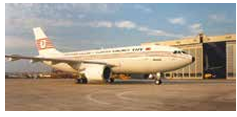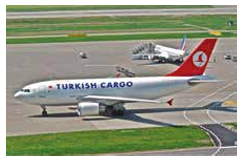
THE SONG THAT NEVER ENDS:
A TRIBUTE TO AIRBUS A300/A310 AIRCRAFT
The saying “If the old were in demand, the flea market would be crowded” is not always true. The A310 aircraft, which can be described as a shorter and more modern version of the A300 aircraft, the first wide-body aircraft produced by Airbus, is still in demand in Iran.
In fact, Turkey also has an important role in the A310 having an important place in Iranian civil aviation.
Turkish Airlines has ordered a total of fourteen A310 aircraft for its fleet, making it the fourth largest order for this aircraft.

Airbus A300 aircraft are the ancestors of Boeing B767, B777, B787 and Airbus A330 and A350 aircraft, which we are very familiar with today and which carry the passenger load of long-range routes.
Prior to the A300, wide-body aircraft with three jet engines, such as the Douglas DC-10 or Lockheed Trident, were being produced as a competitor to wide-body aircraft with four jet engines, such as the B747.
The A-300, the first wide-body aircraft with two jet engines, was also the first aircraft produced by Airbus. Founded by Germany and France in 1970, the Airbus partnership was joined by Spain in 1971 and the UK in 1979.
Airbus delivered its first aircraft, the A300, to its first customer, the French airline Air France, on May 30, 1974. The world’s first wide-body passenger aircraft with two jet engines was made possible by the development of jet engine technology.
ETOPS, which allows twin-engine jet airliners to fly long distances between two airports, owes its emergence to the fact that the frequency of jet engine failures has been greatly reduced thanks to improved production and maintenance technologies.
For ETOPS, the first condition is that when one of the two engines fails, the only engine that remains intact must be powerful enough to continue to carry the aircraft. The second condition is to ensure that the probability of failure of both engines is very small. In addition, the APU must be active, special fire warning and extinguishing systems, generators must not be malfunctioning, etc. for ETOPS aircraft.
Airbus has produced A300 aircraft for 33 years. Of the 561 aircraft produced during this period, 235 of them, nearly half of them, are still in active use. The wide body, range, speed and economy of the aircraft with its two engines have encouraged the conversion of A300 passenger aircraft that have reached the end of their economic life into cargo aircraft. Thus, these aircraft were saved from being scrapped.
Following the interest in the A300, Airbus started working on the A310 passenger aircraft, which is shorter but more advanced than the A300, and delivered its first aircraft to Lufthansa and Swiss Air in 1985.
Airbus produced A310 aircraft for 22 years. Of the 255 aircraft produced during this period, 61 are still in active use.
Turkish Airlines was among the first airlines to use the airplane. The aircraft, which served in the Turkish Airlines fleet for a long time and enabled the opening of many long-range routes from Singapore to New York, completed their duties after the introduction of modern A340 aircraft into the fleet.

Turkish Airlines converted three of the most recent additions to the fleet, TC-JCV, TC-JCY and TC-JCZ, into cargo aircraft. The other aircraft were sold to Iranian airlines Iran Air and Mahan Air.
The Iranian airlines were satisfied with these aircraft and the difficulty they had in obtaining new aircraft from the US and Europe led to the continuing life of these aircraft in Iran.


This article addresses Iran’s new airline Ava Airlines, which started operations in February 2024, made its first flight from Tehran to Istanbul on August 1 with a newly delivered Airbus A310 aircraft. Although the airline is new, the route is new and the aircraft is new, the aircraft itself is not new.
The aircraft with tail mark EP-RBD is 34 years old. The aircraft, which was in the fleet of Uzbekistan for many years with the tail mark UK-31002, was transferred to Tajikistan’s Asia Sky airline in July 2023. The plane did not fly here. It was leased to Iran Air. Later, the aircraft traveled around different Iranian airline companies, but the tail number EP-RBD remained the same. Similar to how new car buyers take a test drive at the dealership, the plane flew for a short time with Qeshm Air and Meraj Air and then joined the fleet of Ava Airlines to make its first flight between Tehran and Istanbul.
The average age of the passenger aircraft fleet of Ava Airlines, based at Tehran’s Mehrabad airport, is 32 years old. The fleet includes a 34-year-old A310, a 34-year-old Mc Donnell Douglas MD-83 and two 31-year-old B737-500 passenger aircraft.
Taking into account flights to both Istanbul airports, Tehran is by far the leader among foreign cities sending the most passengers to Istanbul.
In May 2024, there were over 20 daily round trip flights from Tehran to Istanbul airports. These flights carried a total of 1210 passengers per day in each direction and a total of 75000 passengers per month on both directions.
Three of the airlines operating flights between Istanbul and Tehran are Turkish airlines and nine are Iranian airlines.
Turkish Airlines flies to Tehran from Istanbul airport with A321ceo, A330-200/300, 737-800, 737-900ER aircraft. AJet airline flies to Tehran from Sabiha Gökçen airport with A320neo aircraft. Pegasus airline flies to Tehran from Sabiha Gökçen airport with A321neo aircraft.

All nine Iranian airlines fly from Tehran to Istanbul airport. They do not fly to Sabiha Gökçen airport on the Anatolian side.
It is impressive to see that the aircraft used by Iranian airlines on their flights to Istanbul include Airbus A310 as well as Airbus A300 aircraft.
In addition to Ava Air’s Airbus A310, Iran Air uses Iran Air Airbus A300-600 and A310-300, Iran Airtour Airbus A310-300, Qeshm Air Airbus A300-600, Mahan Air Airbus A310-300, Meraj Airlines Airbus A300-600 and Yazd Airlines Airbus A310-300 on flights between Tehran and Istanbul. Iran Aseman and Mahan Air also use A340-300 aircraft on these flights. Meraj Airlines also uses A320ceo aircraft in addition to the A300-600 aircraft.